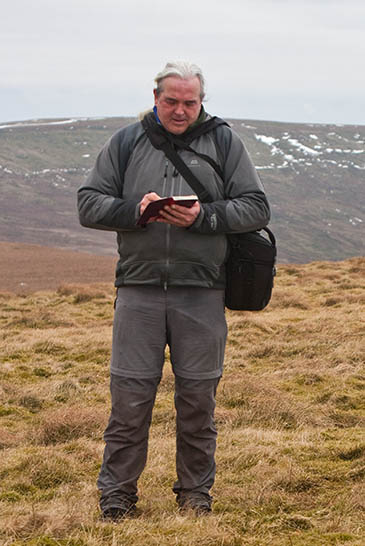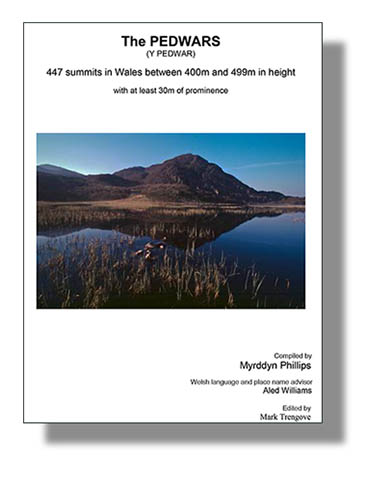The UK has a plethora of hill lists for walkers to bag: munros, hewitts, deweys, humps and tumps.
And now, there’s a new list to aim for: the Pedwars.
Devised by Myrddyn Phillips, one of the three amateur hills sleuths who regularly lug their professional-grade GPS gear up mountains to measure their altitude, the new Welsh list is designed to take walkers to new heights.
Here, Myrddyn explains his new list, available to view online.
Hillwalkers now have a new challenge, one that will take them to areas where few people tread.
This challenge is the Pedwars, a listing of Welsh hills that comprise 447 summits spread across some of the wildest and most beautiful landscapes that Wales has to offer.
A ‘Pedwar’ is a hill in Wales between the heights of 400m and 499m that has a minimum drop of 30m.
As this list deals with the 400m hills and as there’s a grand total of 447 of them it felt rather apt to name them the Pedwars as the Welsh word pedwar translates as four.
As list compiler, Myrddyn has visited more than half of these hills. He said: “Over recent years, some of those completing the 2,000ft hewitt mountains progress toward the deweys. These are the 500m hills first listed in published format by Michael Dewey.
“However, the uplands in Britain south of the Scottish border do not start at a height of 500m. There are many hill areas throughout Wales, England, the Isle of Man, and also Ireland where land at 400m or above comprises wild, little frequented moorland that is mountainous in nature.
For Wales this is the ‘Land of the Pedwars’.”
The list has been compiled from the most recently available online mapping and takes in the remotest of Welsh hills.
For those intrepid hill walkers who are nearing their completion of Welsh hewitts and deweys, an extension to attempt a full completion of the Welsh uplands would need to take in the Pedwars.
This would prove a considerable undertaking, but would leave the hillwalker with an intimate knowledge of all the upland areas of Wales.
The Pedwar list is available to print off, free of charge from the Europeaklist website.
There is also an e-book version available. The website and Pedwar editor Mark Trengove said: “The Europeaklist website has been in operation for a number of years.
“We specialise in listings of European hills and mountains from a variety of countries, but we also indulge ourselves in publishing some new British listings, so far not published elsewhere.’’
But why does the list of Pedwars redefine the Welsh hills?
The unique element with this listing is that each and every hill name has been researched to a high degree. Many were discovered from local farmers or found on some of the first maps that were ever available to the public.
The bulk of this painstaking work has been conducted by Aled Williams who, as the Welsh language and place-name advisor for the Pedwar listing said: “Research into the names of the Pedwars proved a great challenge.
“As well as the 447 hills in the main list, there are another 270 hills in three sub-lists.
“So with over 700 hill names to research and analyse for their composition, any free time I’ve had for the last few months has been spent either walking the hills or doing research into their names.”
This place-name research is continuing, with both Aled and Myrddyn being part of the Hill Names in Wales Research team.
The Pedwars is published free of charge by Europeaklist under the Wales section.


charles everett
27 May 2013Fascinating to see another great list of 400metre summits to tackle in Wales.
Looks like a great amount of diligent research into not only the hill lists but all the names too.
I wonder how long it took to do the place name research?
Anyway, excellent work by Myrddyn and Aled.
Look forward to adding them as options to my hill tramping, though must admit that when I decided to add the HuMPs on to my Sheet 116 recently, I was almost dismayed that to the 8 Marilyns there was now added a whopping 18 HuMPs. Phew that was almost enough to give me the hump!!!
Charles
Aled Williams
27 May 2013Thanks for the kind comments Charles.
As you know my role was to asses every hill that appears in the list for an appropriate name, and this process took around 4 months to complete. Myrddyn and I have collected a considerable amount of local upland place-names over the years and so we also had the weight of local knowledge to help us with some of the difficult hills. This is all thanks to the interest and kindness of the local people we've spoken to. Any hills where doubt remained we left unnamed, and as our research progresses we hope to uncover the names of such hills.
Aled.